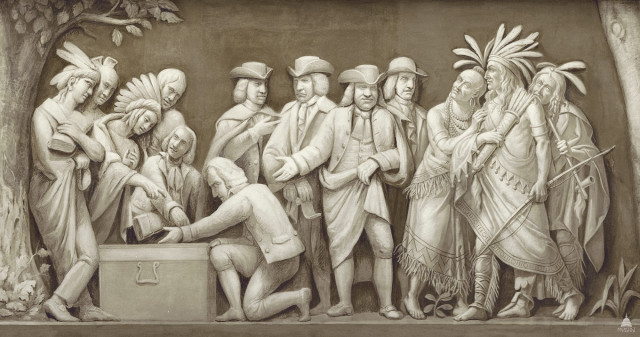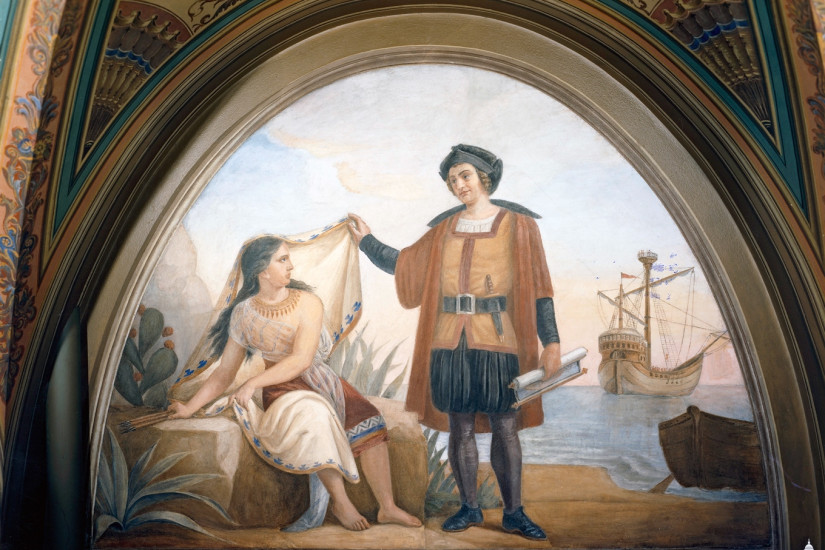The Capitol was begun in 1793, finished in 1800, and rebuilt after it was set on fire during the War of 1812. It has been modified and expanded since, of course, but it took the shape that it now has early on. The Rotunda was always envisioned as a site of public memory and national storytelling. The original plan called for a glass floor that would allow sightseers to peer two levels down into George Washington’s crypt — which was intended to be placed in the Capitol, though ultimately it was not — making the hall a pilgrimage site for contact with sacred relics. A later design proposed reliefs in niches depicting 24 heroes of the Revolutionary War. Finally, between 1817 and 1855, Trumbull and several other artists were commissioned to create the work in the Rotunda today: a series of eight large oil paintings showing Columbus’ landing, Henry De Soto’s “discovery” of the Mississippi River, the embarkation of Pilgrims from Holland, the baptism of Pocahontas, two battle scenes from the American Revolution, the drafting of the Declaration of Independence, and the resignation of George Washington as Commander-in-Chief.

Constantino Brumidi, “William Penn and the Indians, 1682″ (ca 1878-1880), The Frieze of American History, Capitol Rotunda. [Architect of the Capitol via Flickr, in the public domain]

Filippo Costaggini, “Oglethorpe and the Indians, 1732” (ca. 1889); The Frieze of American History, Capitol Rotunda. [Architect of the Capitol via Flickr, in the public domain]
Another series of relief panels above these paintings and over the Rotunda’s four doorways depict early explorers and scenes from colonial history, and above that, more than 50 feet off the ground, a grisaille frieze titled The Frieze of American History circles the drum of the dome with nineteen scenes of national mythmaking, from the arrival of Columbus through the 1903 flight of the Wright Brothers at Kitty Hawk. (The Frieze was begun by Constantino Brumidi in 1877 and continued in the 1889s by Filippo Costaggini, with three last panels added by Allyn Cox in 1951.) Flanking doorways and placed between the paintings are statues of nine former presidents, along with Alexander Hamilton, Martin Luther King, Jr., and a group sculpture of suffragists Lucretia Mott, Elizabeth Cady Stanton, and Susan B. Anthony. On the ceiling of the dome, Brumidi’s Apotheosis of Washington (1865) shows the Founding Father enthroned in the heavens, surrounded by allegorical figures representing strength and industry.
This is a space, then, that is dense with narratives of divinely ordained conquest and White male heroism. Given the number of individual works and the fact that some 25 artists have contributed to this site across a span of time nearly coincident with the life of the nation, it is notable how neatly this unified vision can be broken down into three iconographic categories and their associated ideological propositions. These propositions are 1) European explorers such as Columbus or Sir Walter Raleigh, conceived as the advance guard for settlers who arrived a century later, exercised a legitimate claim to North American lands; 2) Native peoples accepted and indeed actively legitimized colonization; and 3) the Founding Fathers represent our semi-sacred origin, remaining the essential allegorical figures who bind together our notion of “America” with both the principles and the history of democracy.

 2021, yet the Capitol remains closed for public tours as of this writing, offering only virtual tours and other online programs. A cynic might say that the transformation is complete: What was once a site of broad participation in direct democracy has flattened into media that consumers view online.
2021, yet the Capitol remains closed for public tours as of this writing, offering only virtual tours and other online programs. A cynic might say that the transformation is complete: What was once a site of broad participation in direct democracy has flattened into media that consumers view online.